Chao Tang
DeepInverse: A Python package for solving imaging inverse problems with deep learning
May 26, 2025Abstract:DeepInverse is an open-source PyTorch-based library for solving imaging inverse problems. The library covers all crucial steps in image reconstruction from the efficient implementation of forward operators (e.g., optics, MRI, tomography), to the definition and resolution of variational problems and the design and training of advanced neural network architectures. In this paper, we describe the main functionality of the library and discuss the main design choices.
An Empirical Study of GPT-4o Image Generation Capabilities
Apr 08, 2025Abstract:The landscape of image generation has rapidly evolved, from early GAN-based approaches to diffusion models and, most recently, to unified generative architectures that seek to bridge understanding and generation tasks. Recent advances, especially the GPT-4o, have demonstrated the feasibility of high-fidelity multimodal generation, their architectural design remains mysterious and unpublished. This prompts the question of whether image and text generation have already been successfully integrated into a unified framework for those methods. In this work, we conduct an empirical study of GPT-4o's image generation capabilities, benchmarking it against leading open-source and commercial models. Our evaluation covers four main categories, including text-to-image, image-to-image, image-to-3D, and image-to-X generation, with more than 20 tasks. Our analysis highlights the strengths and limitations of GPT-4o under various settings, and situates it within the broader evolution of generative modeling. Through this investigation, we identify promising directions for future unified generative models, emphasizing the role of architectural design and data scaling.
Dexterous Manipulation through Imitation Learning: A Survey
Apr 04, 2025Abstract:Dexterous manipulation, which refers to the ability of a robotic hand or multi-fingered end-effector to skillfully control, reorient, and manipulate objects through precise, coordinated finger movements and adaptive force modulation, enables complex interactions similar to human hand dexterity. With recent advances in robotics and machine learning, there is a growing demand for these systems to operate in complex and unstructured environments. Traditional model-based approaches struggle to generalize across tasks and object variations due to the high-dimensionality and complex contact dynamics of dexterous manipulation. Although model-free methods such as reinforcement learning (RL) show promise, they require extensive training, large-scale interaction data, and carefully designed rewards for stability and effectiveness. Imitation learning (IL) offers an alternative by allowing robots to acquire dexterous manipulation skills directly from expert demonstrations, capturing fine-grained coordination and contact dynamics while bypassing the need for explicit modeling and large-scale trial-and-error. This survey provides an overview of dexterous manipulation methods based on imitation learning (IL), details recent advances, and addresses key challenges in the field. Additionally, it explores potential research directions to enhance IL-driven dexterous manipulation. Our goal is to offer researchers and practitioners a comprehensive introduction to this rapidly evolving domain.
The R2D2 Deep Neural Network Series for Scalable Non-Cartesian Magnetic Resonance Imaging
Mar 13, 2025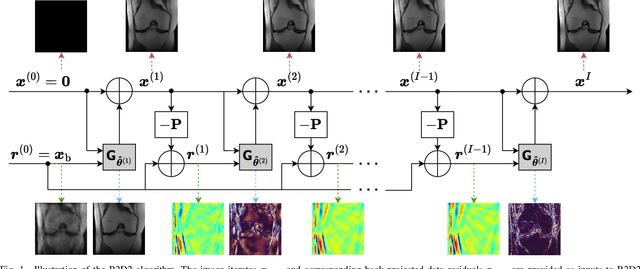
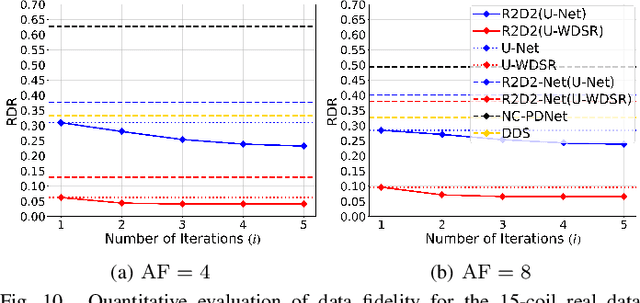

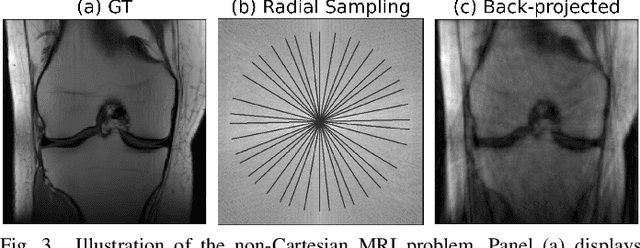
Abstract:We introduce the R2D2 Deep Neural Network (DNN) series paradigm for fast and scalable image reconstruction from highly-accelerated non-Cartesian k-space acquisitions in Magnetic Resonance Imaging (MRI). While unrolled DNN architectures provide a robust image formation approach via data-consistency layers, embedding non-uniform fast Fourier transform operators in a DNN can become impractical to train at large scale, e.g in 2D MRI with a large number of coils, or for higher-dimensional imaging. Plug-and-play approaches that alternate a learned denoiser blind to the measurement setting with a data-consistency step are not affected by this limitation but their highly iterative nature implies slow reconstruction. To address this scalability challenge, we leverage the R2D2 paradigm that was recently introduced to enable ultra-fast reconstruction for large-scale Fourier imaging in radio astronomy. R2D2's reconstruction is formed as a series of residual images iteratively estimated as outputs of DNN modules taking the previous iteration's data residual as input. The method can be interpreted as a learned version of the Matching Pursuit algorithm. A series of R2D2 DNN modules were sequentially trained in a supervised manner on the fastMRI dataset and validated for 2D multi-coil MRI in simulation and on real data, targeting highly under-sampled radial k-space sampling. Results suggest that a series with only few DNNs achieves superior reconstruction quality over its unrolled incarnation R2D2-Net (whose training is also much less scalable), and over the state-of-the-art diffusion-based "Decomposed Diffusion Sampler" approach (also characterised by a slower reconstruction process).
FlowPlan: Zero-Shot Task Planning with LLM Flow Engineering for Robotic Instruction Following
Mar 04, 2025Abstract:Robotic instruction following tasks require seamless integration of visual perception, task planning, target localization, and motion execution. However, existing task planning methods for instruction following are either data-driven or underperform in zero-shot scenarios due to difficulties in grounding lengthy instructions into actionable plans under operational constraints. To address this, we propose FlowPlan, a structured multi-stage LLM workflow that elevates zero-shot pipeline and bridges the performance gap between zero-shot and data-driven in-context learning methods. By decomposing the planning process into modular stages--task information retrieval, language-level reasoning, symbolic-level planning, and logical evaluation--FlowPlan generates logically coherent action sequences while adhering to operational constraints and further extracts contextual guidance for precise instance-level target localization. Benchmarked on the ALFRED and validated in real-world applications, our method achieves competitive performance relative to data-driven in-context learning methods and demonstrates adaptability across diverse environments. This work advances zero-shot task planning in robotic systems without reliance on labeled data. Project website: https://instruction-following-project.github.io/.
Towards a robust R2D2 paradigm for radio-interferometric imaging: revisiting DNN training and architecture
Mar 04, 2025Abstract:The R2D2 Deep Neural Network (DNN) series was recently introduced for image formation in radio interferometry. It can be understood as a learned version of CLEAN, whose minor cycles are substituted with DNNs. We revisit R2D2 on the grounds of series convergence, training methodology, and DNN architecture, improving its robustness in terms of generalisability beyond training conditions, capability to deliver high data fidelity, and epistemic uncertainty. Firstly, while still focusing on telescope-specific training, we enhance the learning process by randomising Fourier sampling integration times, incorporating multi-scan multi-noise configurations, and varying imaging settings, including pixel resolution and visibility-weighting scheme. Secondly, we introduce a convergence criterion whereby the reconstruction process stops when the data residual is compatible with noise, rather than simply using all available DNNs. This not only increases the reconstruction efficiency by reducing its computational cost, but also refines training by pruning out the data/image pairs for which optimal data fidelity is reached before training the next DNN. Thirdly, we substitute R2D2's early U-Net DNN with a novel architecture (U-WDSR) combining U-Net and WDSR, which leverages wide activation, dense connections, weight normalisation, and low-rank convolution to improve feature reuse and reconstruction precision. As previously, R2D2 was trained for monochromatic intensity imaging with the Very Large Array (VLA) at fixed $512 \times 512$ image size. Simulations on a wide range of inverse problems and a case study on real data reveal that the new R2D2 model consistently outperforms its earlier version in image reconstruction quality, data fidelity, and epistemic uncertainty.
FUNCTO: Function-Centric One-Shot Imitation Learning for Tool Manipulation
Feb 17, 2025



Abstract:Learning tool use from a single human demonstration video offers a highly intuitive and efficient approach to robot teaching. While humans can effortlessly generalize a demonstrated tool manipulation skill to diverse tools that support the same function (e.g., pouring with a mug versus a teapot), current one-shot imitation learning (OSIL) methods struggle to achieve this. A key challenge lies in establishing functional correspondences between demonstration and test tools, considering significant geometric variations among tools with the same function (i.e., intra-function variations). To address this challenge, we propose FUNCTO (Function-Centric OSIL for Tool Manipulation), an OSIL method that establishes function-centric correspondences with a 3D functional keypoint representation, enabling robots to generalize tool manipulation skills from a single human demonstration video to novel tools with the same function despite significant intra-function variations. With this formulation, we factorize FUNCTO into three stages: (1) functional keypoint extraction, (2) function-centric correspondence establishment, and (3) functional keypoint-based action planning. We evaluate FUNCTO against exiting modular OSIL methods and end-to-end behavioral cloning methods through real-robot experiments on diverse tool manipulation tasks. The results demonstrate the superiority of FUNCTO when generalizing to novel tools with intra-function geometric variations. More details are available at https://sites.google.com/view/functo.
DiffSensei: Bridging Multi-Modal LLMs and Diffusion Models for Customized Manga Generation
Dec 10, 2024
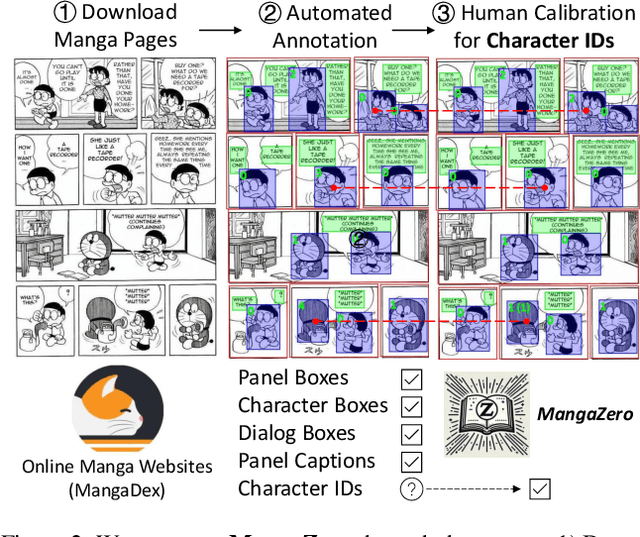
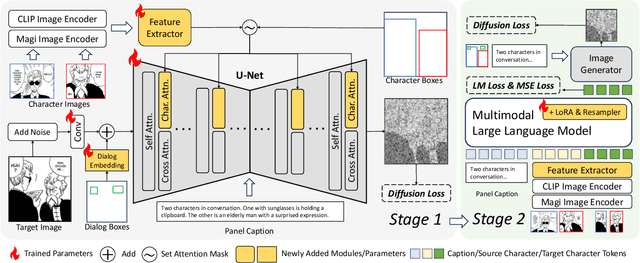

Abstract:Story visualization, the task of creating visual narratives from textual descriptions, has seen progress with text-to-image generation models. However, these models often lack effective control over character appearances and interactions, particularly in multi-character scenes. To address these limitations, we propose a new task: \textbf{customized manga generation} and introduce \textbf{DiffSensei}, an innovative framework specifically designed for generating manga with dynamic multi-character control. DiffSensei integrates a diffusion-based image generator with a multimodal large language model (MLLM) that acts as a text-compatible identity adapter. Our approach employs masked cross-attention to seamlessly incorporate character features, enabling precise layout control without direct pixel transfer. Additionally, the MLLM-based adapter adjusts character features to align with panel-specific text cues, allowing flexible adjustments in character expressions, poses, and actions. We also introduce \textbf{MangaZero}, a large-scale dataset tailored to this task, containing 43,264 manga pages and 427,147 annotated panels, supporting the visualization of varied character interactions and movements across sequential frames. Extensive experiments demonstrate that DiffSensei outperforms existing models, marking a significant advancement in manga generation by enabling text-adaptable character customization. The project page is https://jianzongwu.github.io/projects/diffsensei/.
RTAGrasp: Learning Task-Oriented Grasping from Human Videos via Retrieval, Transfer, and Alignment
Sep 24, 2024Abstract:Task-oriented grasping (TOG) is crucial for robots to accomplish manipulation tasks, requiring the determination of TOG positions and directions. Existing methods either rely on costly manual TOG annotations or only extract coarse grasping positions or regions from human demonstrations, limiting their practicality in real-world applications. To address these limitations, we introduce RTAGrasp, a Retrieval, Transfer, and Alignment framework inspired by human grasping strategies. Specifically, our approach first effortlessly constructs a robot memory from human grasping demonstration videos, extracting both TOG position and direction constraints. Then, given a task instruction and a visual observation of the target object, RTAGrasp retrieves the most similar human grasping experience from its memory and leverages semantic matching capabilities of vision foundation models to transfer the TOG constraints to the target object in a training-free manner. Finally, RTAGrasp aligns the transferred TOG constraints with the robot's action for execution. Evaluations on the public TOG benchmark, TaskGrasp dataset, show the competitive performance of RTAGrasp on both seen and unseen object categories compared to existing baseline methods. Real-world experiments further validate its effectiveness on a robotic arm. Our code, appendix, and video are available at \url{https://sites.google.com/view/rtagrasp/home}.
Scene-wise Adaptive Network for Dynamic Cold-start Scenes Optimization in CTR Prediction
Aug 15, 2024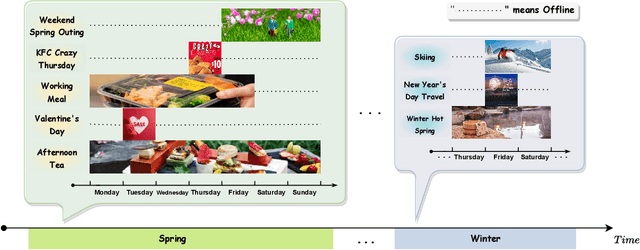

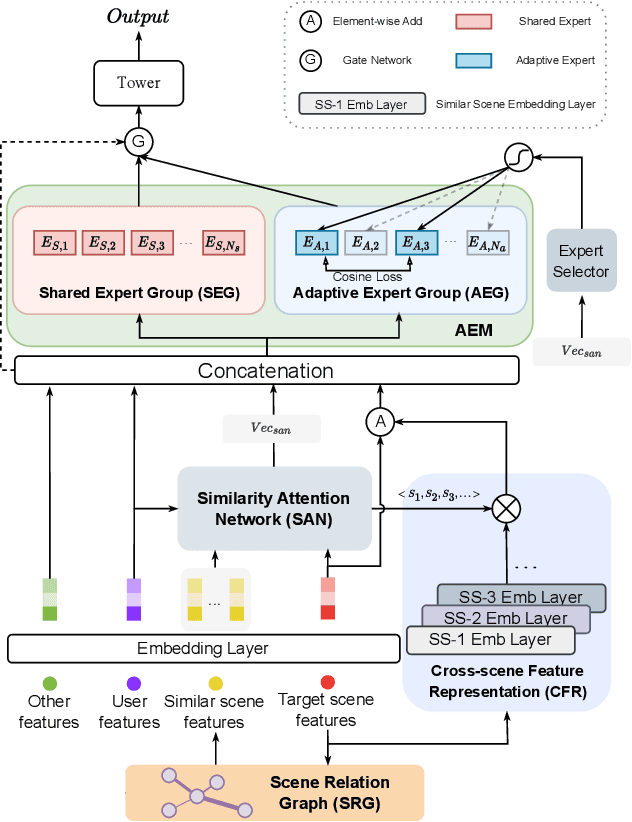
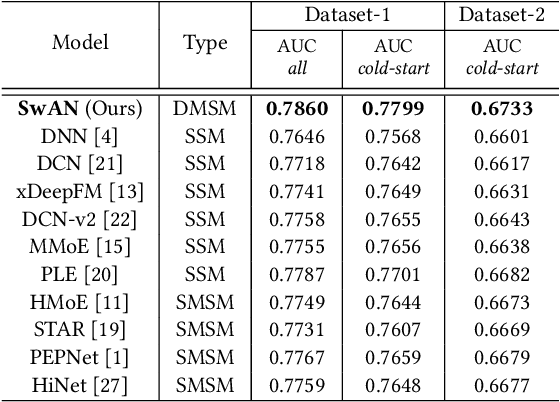
Abstract:In the realm of modern mobile E-commerce, providing users with nearby commercial service recommendations through location-based online services has become increasingly vital. While machine learning approaches have shown promise in multi-scene recommendation, existing methodologies often struggle to address cold-start problems in unprecedented scenes: the increasing diversity of commercial choices, along with the short online lifespan of scenes, give rise to the complexity of effective recommendations in online and dynamic scenes. In this work, we propose Scene-wise Adaptive Network (SwAN), a novel approach that emphasizes high-performance cold-start online recommendations for new scenes. Our approach introduces several crucial capabilities, including scene similarity learning, user-specific scene transition cognition, scene-specific information construction for the new scene, and enhancing the diverged logical information between scenes. We demonstrate SwAN's potential to optimize dynamic multi-scene recommendation problems by effectively online handling cold-start recommendations for any newly arrived scenes. More encouragingly, SwAN has been successfully deployed in Meituan's online catering recommendation service, which serves millions of customers per day, and SwAN has achieved a 5.64% CTR index improvement relative to the baselines and a 5.19% increase in daily order volume proportion.
 Add to Chrome
Add to Chrome Add to Firefox
Add to Firefox Add to Edge
Add to Edge